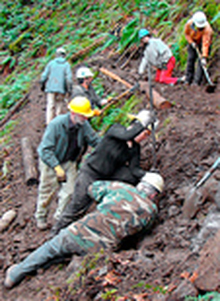Back Country Horsemen of America takes very seriously their mission to ensure that public lands remain open to recreational stock use, and they know that their hard work also allows other user groups to enjoy more recreation opportunities. But sometimes BCHA’s on-the-ground trail work makes a difference in other, unexpected ways.

Back Country Horsemen at work
Sometimes Back Country Horsemen of America’s on-the-ground trail work makes a difference in unexpected ways such as when the cleared trails aid firefighters as they fight wild fires.
© 2017 by BCHA
Reclaiming Neglected Horse Trails
From July 28 through 31, 2015, eight members of the San Joaquin-Sierra Back Country Horsemen of California joined four US Forest Service workers clearing a two mile long trail that connects the Rancheria Trail to Spanish Lake in the John Muir Wilderness of the Sierra National Forest.
The trail was so overgrown and neglected that they sometimes had difficulty finding the original path. After several long days of hard labor, the team had removed 64 downed trees and cleared over 1000 feet of trail, making it passable once again for all trail users, including equestrians.
Mission Accomplished, Just in Time
On July 31, the day they finished their work and packed out to head home, lightning struck about five miles north of Hume Lake, not far from where they had been working. It started the largest wildfire California saw that year. The Rough Fire burned unchecked until it destroyed 151,623 acres and was finally contained on November 5.
The Original Horsepower Protects Wilderness Areas
When wildfires burn in wilderness areas, firefighters try to honor the rules in place to protect those lands by using Minimum Impact Suppression Tactics (MIST). This includes using pack stock instead of mechanized transport to deliver supplies to firefighting crews. The USFS called on their packers to relay supplies to four different groups that were fighting the fire.
Because the trail to Spanish Lake was clear, it was used as a fire line for the back burn. Firefighters set backfires to burn up the available fuel and stop the progression of the wildfire, which was heading toward drought-stricken timbered areas that would have allowed the fire to gain strength and speed. The accessible trail gave firefighters an open area to set backfires as well as providing an easy route for pack horses and mules to deliver supplies to various teams along the fire line.
Once the back burn started moving away from the trail and towards the main fire, the recently opened corridor was invaluable in allowing firefighters to make daily patrols to ensure no burning material came down across the trail which could have started a new fire on the other side of the fire line. The crews remained vigilant until they knew the flames were fully suppressed.
Fighting the Fire Breathing Dragon
The Rough Fire burned almost twice as many acres as the second largest wildfire in California that year, and required 3,742 firefighters with 345 engines, 19 helicopters, and 45 bulldozers to contain. It threatened life and property, necessitating evacuation of Hume Lake Christian Camps, Dunlap, and the Wilsonia and General Grant Grove areas.
The fire approached (but didn’t reach) the heavily populated areas of Fresno and Clovis. It resulted in ten injuries, one of them a firefighter who suffered severe burns and was airlifted to a medical facility, and hospital emergency rooms filled with folks with respiratory distress due to smoke inhalation.
The fire line along the newly re-opened trail proved to be a major factor in containing this massive wildfire. The Back Country Horsemen of the San Joaquin-Sierra Chapter were just doing what they do: keeping trails open for all users to enjoy.
They didn’t know that accomplishing this humble task would make it possible to keep a fire-breathing dragon from becoming an even bigger monster and swallowing up more of the state’s stunning landscape and maybe even claiming human lives and homes.
About Back Country Horsemen of America
BCHA is a non-profit corporation made up of state organizations, affiliates, and at-large members. Their efforts have brought about positive changes regarding the use of horses and stock in wilderness and public lands.
If you want to know more about Back Country Horsemen of America or become a member, visit their website: www.bcha.org; call 888-893-5161; or write 342 North Main Street, West Hartford, CT 06117. The future of horse use on public lands is in our hands!
